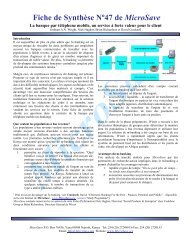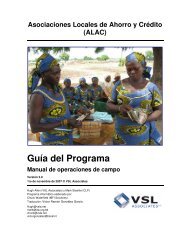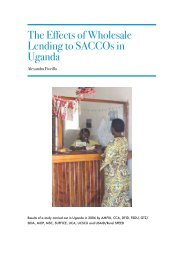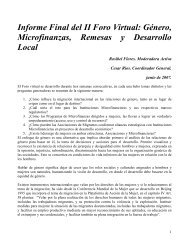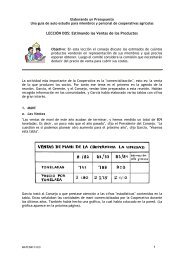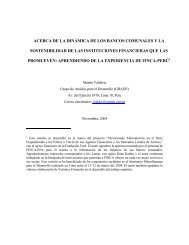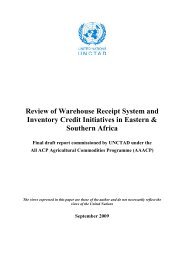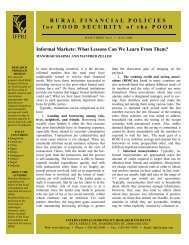Finance - Rural Finance Learning Center
Finance - Rural Finance Learning Center
Finance - Rural Finance Learning Center
Create successful ePaper yourself
Turn your PDF publications into a flip-book with our unique Google optimized e-Paper software.
<strong>Finance</strong> Study Guide Lesson 5<br />
The information in both examples is exactly the same with the exception of the<br />
aging figures. Note the difference in Amount Past Due as a percentage of<br />
Outstanding Loans (6.8%) and the Portfolio at Risk as a percentage of Outstanding<br />
Loans (19.8%). How much of the portfolio is in fact at risk?<br />
Taking the examples and looking at them over time, if the Amount Past Due or<br />
Portfolio at Risk in the later categories is increasing, then the delinquency problem<br />
is deteriorating and is an indication to management that there is an increasing<br />
problem with the quality of the portfolio.<br />
Calculating the Portfolio at Risk should be done for each aging category to<br />
determine the length of time past due loans have been past due and to make an<br />
estimate of the required Loan loss reserve (discussed below). Aging of Portfolio at<br />
Risk amounts also allows fund managers to determine if new policies implemented<br />
to control delinquencies are working. Aging of Portfolio at Risk Reports should be<br />
calculated periodically. They can be calculated for a micro-finance organization as<br />
a whole, for a region, a branch, a credit officer or by sector (activity or geographic<br />
split). Aging of Portfolio at Risk reports should be compared over time with<br />
previous reports rather than as a comparison between branches or organizations.<br />
This is because there are circumstances particular to each branch or organization,<br />
such as age, the make-up of the loan portfolio, etc., that affect the delinquency.<br />
Discuss the use of analyzing the aging of the portfolio over time and how it can help<br />
all staff of a micro-finance organization manage the risk in their portfolios.<br />
Loan Loss Reserves<br />
Aging of the Portfolio at Risk creates the information required to establish the<br />
adequacy of the Loan loss reserve. A Loan loss reserve is an accounting entry (as<br />
discussed in the Accounting Study Guide) which represents the amount of<br />
outstanding principal that is not expected to be recovered by a micro-finance<br />
organization. The longer a loan is in arrears, the lower is the chance of<br />
receiving payment.<br />
The Loan loss reserve can be stated as a percentage of outstanding loans.<br />
Loan loss reserve Ratio = Total Reserve<br />
Average Portfolio Outstanding<br />
The amount of the Loan loss reserve should be based on historical information<br />
regarding loan default and the aging analysis and should be calculated periodically<br />
(e.g., monthly, quarterly) to determine whether a Loan loss provision needs to be<br />
made to adjust the Reserve. 3 The Reserve as a percentage of loans outstanding<br />
may be set by regulation in some countries if the micro-finance organization is<br />
regulated as a formal financial institution. If it is not, the rate should be<br />
determined for each category of arrears based on what the organization thinks is<br />
the probability of the loan defaulting. For example, if approximately 10% of loans<br />
which are past due less than 30 days end up defaulting, a provision of 10% should be<br />
created. If 50% of loans which are past due more than 60 days but less than 180<br />
days end up defaulting, a 50% provision should be created. Look at the following<br />
Sample Aging Report:<br />
3 The Loan loss reserve is recorded as a negative asset on the Balance Sheet as a reduction of the<br />
Outstanding Portfolio or as a liability. The Loan loss provision is the amount expensed on the Income<br />
Statement. Loan loss provisions increase the Loan loss reserve while Write-offs decrease the Reserve and<br />
the Outstanding Portfolio.<br />
Calmeadow 8




